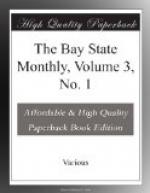The real Shem Drowne was not a wood-carver; no authority for such a statement can be found. His trade is given as that of a “tin plate worker,"[5] and a “cunning artificer” in metal;[6] nowhere as a wood-carver. He was born in Kittery, Maine, in 1683. His father was Leonard Drowne, who came from the west of England to Kittery, where he carried on the ship building business until 1692, when, on account of the French and Indian wars, he removed his family to Boston, where he died, a few years after, and his grave is in the old Copp’s Hill Burying Ground.[7] At Boston Shem Browne established himself in his trade. He was elected a deacon of the First Baptist Church, in 1721. He was “often employed in Town affairs, especially in the management of Fortifications."[8]
He married Catherine Clark, one of the heirs of Nicholas Bavison, of Charlestown, who was a purchaser in the “Pemaquid Patent,” or grant of the Plymouth Company, of some twelve thousand acres, to Messrs. Aldsworth and Elbridge of Bristol, England, made in 1631. Becoming interested in the claim of his wife, as one of the heirs, in 1735, he was appointed agent and attorney of the “Pemaquid Proprietors,” in which capacity he acted for many years. It was sometimes called the “Drowne Claim.” In 1747 he had the whole tract of land surveyed, and was instrumental in causing forty or more families to settle in that region. That he became blind, or nearly so, as early as 1762, is attested by a deed of land at Broad Cove (Bristol, Maine), made in that year to Thomas Johnston; a note in the margin of which states that it was “distinctly read to him on account of his sight;"[9] but the signature is written in a large, plain hand. He died January 13, 1774, aged ninety-one years. He had a daughter, Sarah, who, in 1757, was married to Rev. Jeremiah Condy, who, from 1739 to 1764, was pastor of the First Baptist Church, of which church Mr. Drowne was a deacon. As a metal worker he made the grasshopper, Indian, and other vanes; but that he ever carved a pump head, urn, gate-post, “Admiral Vernon,” or any other wooden image, there is not a scintilla of evidence; nothing but the figment of a romancer’s brain.




